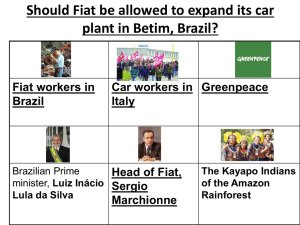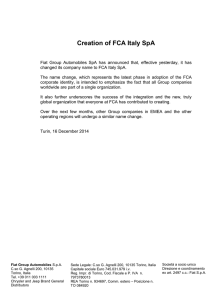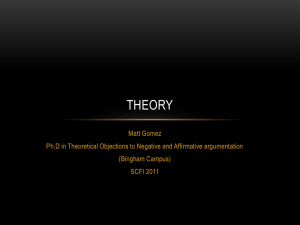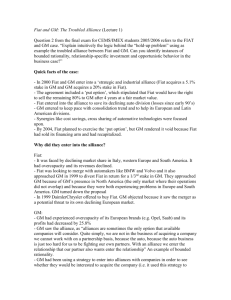Kearney.NJSD.2.2.Edited.1.17.14 - KU ScholarWorks
advertisement
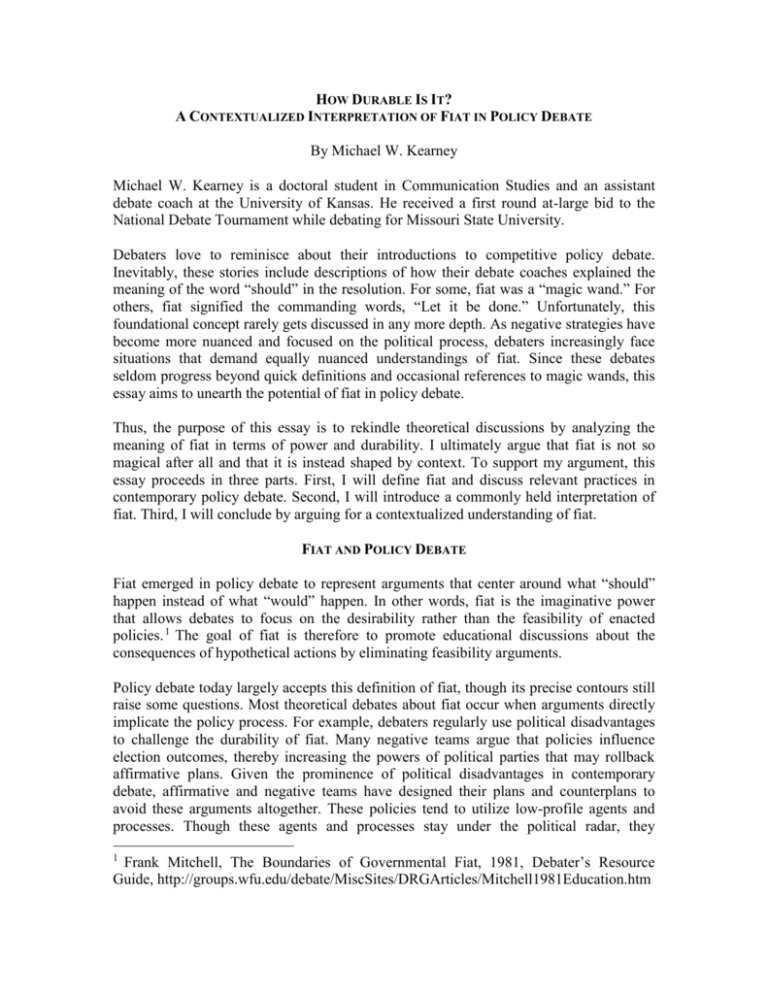
HOW DURABLE IS IT? A CONTEXTUALIZED INTERPRETATION OF FIAT IN POLICY DEBATE By Michael W. Kearney Michael W. Kearney is a doctoral student in Communication Studies and an assistant debate coach at the University of Kansas. He received a first round at-large bid to the National Debate Tournament while debating for Missouri State University. Debaters love to reminisce about their introductions to competitive policy debate. Inevitably, these stories include descriptions of how their debate coaches explained the meaning of the word “should” in the resolution. For some, fiat was a “magic wand.” For others, fiat signified the commanding words, “Let it be done.” Unfortunately, this foundational concept rarely gets discussed in any more depth. As negative strategies have become more nuanced and focused on the political process, debaters increasingly face situations that demand equally nuanced understandings of fiat. Since these debates seldom progress beyond quick definitions and occasional references to magic wands, this essay aims to unearth the potential of fiat in policy debate. Thus, the purpose of this essay is to rekindle theoretical discussions by analyzing the meaning of fiat in terms of power and durability. I ultimately argue that fiat is not so magical after all and that it is instead shaped by context. To support my argument, this essay proceeds in three parts. First, I will define fiat and discuss relevant practices in contemporary policy debate. Second, I will introduce a commonly held interpretation of fiat. Third, I will conclude by arguing for a contextualized understanding of fiat. FIAT AND POLICY DEBATE Fiat emerged in policy debate to represent arguments that center around what “should” happen instead of what “would” happen. In other words, fiat is the imaginative power that allows debates to focus on the desirability rather than the feasibility of enacted policies. 1 The goal of fiat is therefore to promote educational discussions about the consequences of hypothetical actions by eliminating feasibility arguments. Policy debate today largely accepts this definition of fiat, though its precise contours still raise some questions. Most theoretical debates about fiat occur when arguments directly implicate the policy process. For example, debaters regularly use political disadvantages to challenge the durability of fiat. Many negative teams argue that policies influence election outcomes, thereby increasing the powers of political parties that may rollback affirmative plans. Given the prominence of political disadvantages in contemporary debate, affirmative and negative teams have designed their plans and counterplans to avoid these arguments altogether. These policies tend to utilize low-profile agents and processes. Though these agents and processes stay under the political radar, they Frank Mitchell, The Boundaries of Governmental Fiat, 1981, Debater’s Resource Guide, http://groups.wfu.edu/debate/MiscSites/DRGArticles/Mitchell1981Education.htm 1 consequently lack the strength of traditional policymaking agents and processes. Yet, contrary to what one might expect, it appears debaters have not successfully challenged the solvency of these policies. FIAT AD INFINITUM I believe these trends have emerged because the sophistication of fiat theory has stagnated. More often than not, when today's debaters encounter arguments that question the durability of their policies, the most common response is simply, “fiat is durable,” presumably representing an alternative understanding of fiat. This implicit interpretation of fiat, which I will refer to as fiat ad infinitum, suggests that fiat is infinite and unbounded by real world forces. In a sense, the utopian nature of this interpretation mirrors a conceptualization of debate as a form of social criticism wherein debaters emphasize the ideal world rather than the real world. 2 In theory, this approach is not without merit. However, given contemporary debate’s emphasis on the real world, fiat ad infinitum seems both unnecessary and counterproductive as it departs too far from topic literature and the real world more generally. CONTEXTUALIZED FIAT As an alternative to fiat ad infinitum, I propose a contextualized understanding of fiat. This proposed interpretation would serve primarily as the justification for debating what “should” be done, but relevant forces would still influence the power and durability of any particular action. In other words, debates would still focus on hypothetically implemented policies, but they would no longer ignore many real world consequences. To better understand this interpretation, I will explain how a contextualized understanding of fiat might fluctuate depending on institutional, attitudinal, and temporal changes. Institutional changes refer to the relative abilities of acting agencies. In many debates, participants introduce evidence that advocates for particular actors, only to later retreat when opposing teams “fiat” a similar action by a different actor. This retreat often occurs because participants struggle to differentiate between the institutional limitations of policy actors. Since fiat ad infinitum treats every action as infinitely durable, debaters presume that decisions made by executive agencies possess the same staying power as decisions made by the President, the Congress, and the Supreme Court. A contextualized interpretation of fiat, on the other hand, would reward debaters who compare the inherent strengths and weakness of institutions. Attitudinal changes refer to the general mood surrounding policies. Though fiat sidesteps feasibility questions, attitudes can still influence policies after passage. Of course, any interpretation of fiat must assume that a policy has enough support to come into existence. However, debate would be ignoring a wealth of history and literature by 2 Brian R. McGee and David Romanelli, Policy Debate as Fiction: In Defense of Utopian Fiat, Contemporary Argumentation and Debate, 18, 1997, 23-25. pretending that every policy carries the same level of support. Here, the lines become less clear, but recent pieces of major legislation help provide some context for these attitudinal forces on policies. Shortly after the passage of Obama’s controversial health care legislation, the judiciary, potential presidential candidates, and an entire political party attempted to reverse the law. 3 Conversely, the almost unanimously supported Patriot Act legislation has slowly given way to growing opposition. 4 Under the fiat ad infinitum interpretation, these policies would be equally durable, and debaters would be denied the opportunity to make arguments regarding the attitudes that shaped real world policies. Temporal changes refer to the potential political, cultural, and economic influences on policies in the future. Political sea changes typically occur when a party gains or regains control over a governmental body. Changes in the executive branch, for example, often produce policy reversals. Since its inception, The Mexico City Gag Rule has been adopted or rescinded according to the political party of the President. 5 Cultural changes have also influenced policies, though these changes generally occur slowly. Recently, cultural changes resulted in the reversals of the Don’t Ask Don’t Tell and Defense Of Marriage Act policies. 6 Finally, economic changes regularly influence policies. In the case of financial regulations, The Glass-Steagall Act was adopted and repealed as the economy expanded and contracted.7 In sum, these changes over time provide the contexts that shape political institutions and policy decisions. Without a contextualized understanding of fiat, however, policy debate would continue to diverge from the political, cultural, and economic forces that create the real world. Debate challenges individuals to research, think critically, and communicate effectively about hypothetical actions. So long as debate continues to emphasize the real world, these skills will require debaters to understand the institutional, attitudinal, and temporal changes that influence real policies. Adopting a contextualized understanding of fiat will 3 John Parkinson and Amy Bingham, The Reality of Repealing Obama's Health Care Law, ABC News, 2012, http://abcnews.go.com/Politics/OTUS/reality-repealing-obamahealth-care-law/story?id=16679832 4 Amy Sullivan, Shhh. Obama Repeals the Abortion Gag Rule, Very Quietly, Time, 2009, http://www.time.com/time/nation/article/0,8599,1873794,00.html 5 Sheryl Gay Stolberg, Once-Lone Foe of Patriot Act Has Company, New York Times, 2005, http://www.nytimes.com/2005/12/19/politics/19patriot.html?pagewanted=all 6 Colleen Walsh, Tracking a cultural shift, Harvard Gazette, http://news.harvard.edu/gazette/story/2013/06/tracking-a-cultural-shift/ 7 2013, Corinne Crawford, The Repeal Of The Glass-Steagall Act And The Current Financial Crisis, Journal of Business & Economics Research, 9, 2011, http://www.unarts.org/HII/ref/949-3747-1-PB-1.pdf not simplify debate, but categorically dismissing real world consequences will certainly dumb it down.
